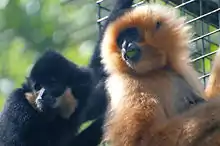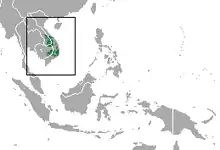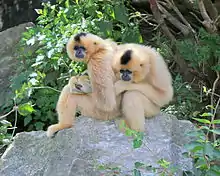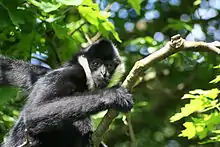Yellow-cheeked gibbon
The yellow-cheeked gibbon (Nomascus gabriellae), also called the golden-cheeked gibbon, yellow-cheeked crested gibbon, the golden-cheeked crested gibbon, red-cheeked gibbon,[2] or the buffed-cheeked gibbon, is a species of gibbon native to Vietnam, Laos, and Cambodia.[2] The species was discovered and named after the British naturalist Gabrielle Maud Vassal.[3]
| Yellow-cheeked gibbon | |
|---|---|
 | |
| (male left; female right) | |
| Scientific classification | |
| Kingdom: | Animalia |
| Phylum: | Chordata |
| Class: | Mammalia |
| Order: | Primates |
| Suborder: | Haplorhini |
| Infraorder: | Simiiformes |
| Family: | Hylobatidae |
| Genus: | Nomascus |
| Species: | N. gabriellae |
| Binomial name | |
| Nomascus gabriellae (Thomas, 1909) | |
 | |
| Yellow-cheeked gibbon range | |

The yellow-cheeked gibbon is born blond and later turns black. Males carry this colouring through their lifespan and have the distinguishing golden cheeks. Females are born blonde to blend into their mother's fur but they later turn black. Females turn back to blond at sexual maturity, keeping only a black cap on the top of their heads.[4]
This diurnal and arboreal gibbon lives in primary tropical forest, foraging for fruits, using brachiation to move through the trees.

The yellow-cheeked gibbon, like all gibbon species, has a unique song, which is usually initiated by the male. The female will then join in and sing with the male to reinforce their bond and announce to other gibbons that they are a pair in a specific territory.[5] The male usually finishes the song after the female has stopped singing.
Little is known about this species in the wild, but it is thought that it has a life span of approximately 46 years.[5]
In 2007, a specimen was born in captivity within the conservation program of the species in which the Fuengirola Zoo participates.
Conservation and rehabilitation
A large protected wild population can be found in Cat Tien National Park: where a collaboration with the Endangered Asian Species Trust (UK), and Pingtung Wildlife Rescue Centre (Taiwan) founded the Dao Tien Endangered Primate Species Centre, which specialises on the rescue, rehabilitation and release of N. gabriellae and other endangered primates.
A report by the Wildlife Conservation Society counted 1,200 yellow-cheeked crested gibbons in Cambodia’s Keo Seima Wildlife Sanctuary, an estimate that represents the largest known population of the species in the world.[6]
References
- Rawson, B.M.; Hoang, M.D.; Roos, C.; Van, N.T.; Nguyen, M.H. (2020). "Nomascus gabriellae". IUCN Red List of Threatened Species. 2020: e.T128073282A17968950. Retrieved 7 September 2020.
- Groves, C. P. (2005). "Order Primates". In Wilson, D. E.; Reeder, D. M (eds.). Mammal Species of the World: A Taxonomic and Geographic Reference (3rd ed.). Johns Hopkins University Press. p. 180. ISBN 978-0-8018-8221-0. OCLC 62265494.
- Gulliver, Katrina (April 2020). "Gabrielle Vassal (1880–1959): collecting specimens in Indochina for the British Museum (Natural History), 1900–1915". Archives of Natural History. 47 (1): 29–40. doi:10.3366/anh.2020.0619.
- Geissman, Thomas. "Fact Sheet: Yellow-Cheeked Crested Gibbon". Retrieved 4 December 2012.
- Quist, Erin. "Nomascus gabriella".
- Nuttall, M., Menghor, N., & O’Kelly, H. (2013). Monitoring of key species in the Seima Protected Forest (p. 29). Phnom Penh, Cambodia: WCS.
